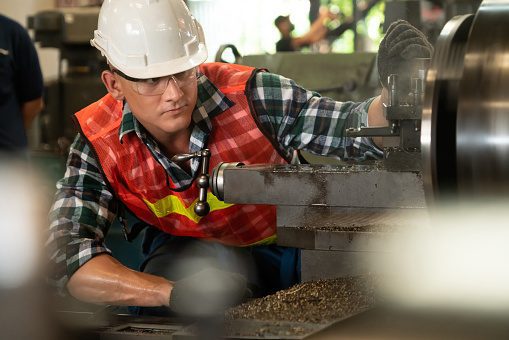
| Machinist Key Stats | |
|---|---|
| Avg. Salary / year | $47,460 |
| Avg. Pay / hour | $22.82 |
| Education | 1-2 Years |
| Job Outlook | 3% |
Machinists use a variety of machine tools in order to create precision metal parts.
These professionals use their hands on skills to use machine tools such as grinders, milling machines and lathes.
These professionals may be responsible for making large quantities of precision metal parts, or smaller batches of several types of precision metal parts.
Continue reading below if you are interested in a career as a Machinist.
Below you will find information regarding the educational requirements to begin this career, a general job description and salary and wage information.
Table of Contents
Education Requirements to Become a Machinist
There are several ways an applicant can become a Machinist.
Some professionals learn their skills on the job but there are several other ways to get started in this field.
A handful of employees become a Machinist by having similar job experience working as tenders, operators or machine setters.
In addition, candidates can apply for an apprenticeship program to learn under an experienced professional while earning a salary.
Finally, students can attend a formal education institution such as a technical or vocational school in order to learn the ropes.
Candidates gaining experience as tenders, operators or machine setters should work on a certain set of skills in order to gain entry as a Machinist.
These skills include mathematical proficiency in trigonometry and geometry.
Additionally, candidates need to be skilled in reading blueprints, drafting and metalworking as well as having some basic computer skills.
Apprenticeship programs are very competitive to get into but once accepted, a candidate will learn a variety of information regarding this profession.
A candidate will learn how to become a Machinist hands on through an apprenticeship offered through a union or manufacturer.
A student will need a high school diploma or a GED in order to be accepted.
In addition, candidates should have knowledge and proficiency in algebra and trigonometry.
Apprenticeship programs typically last up to four years.
During this time, candidates will learn from an experienced machinist.
They will work under the supervision of an experienced Machinist and learn how to use a variety of machine tools and equipment.
Students who enter a program offered through a vocational, technical school or community college will need two years to complete a program and earn their Associate’s degree.
After completing a program, candidates will need on the job training in order to be fully qualified for Machinist jobs.
In most cases, certification is optional.
However, earning a certification from a State apprenticeship board or a college will show employers your abilities and skills.
Certification will also lead to better job opportunities.
Machinist Job Description
A Machinist’s goal is to make several types or one specific kind of precision metal part.
The first step is to read and analyze a previously created blueprint and specification before beginning to make the metal parts.
They will need to determine the type of metal they will shape; they can work with metals such as aluminum, titanium, steel, plastic or silicon.
They will then need to determine where they will begin the cutting to the material they are working with in order to shape it according to the written specifications.
Machinists will then determine the proper machine and tools needed to precision cut the material they are working with.
They will use the accurate speeds in order to prevent accidents or improper shaping.
They will finally use measuring tools to determine accuracy and whether the blueprint instructions have been followed.
Machinist Salary and Career Path
The Bureau of Labor Statistics reports that the national median wage for Machinists in 2008 was approximately $17.41 per hour.
The salary range for these professionals during the same year was approximately $10.79 to $26.60 per hour.
Exact wages for these professionals will depend on geographical location, years of experience and the industry they work in.
The industry that pays the highest wages is the Aerospace product and parts manufacturing while the Employment Services industry pays the lowest wages.
In addition, apprentice Machinists earn lower wages while they train and gain expertise on the job.
The Bureau of Labor Statistics reports that employment opportunities for those who want to become Machinists.
Job opportunities for these professionals are expected to decline by 5 percent through the year 2018.
However, this is not completely bad news for jobseekers.
The number of applicants wanting to enter this field is less than the number of jobs available creating more opportunities for people seeking jobs in this profession.
![]() The below information is based on the 2021 BLS national averages.
The below information is based on the 2021 BLS national averages.
National Average Salary
$49,020Average Salary by State
| State | Avg. Annual Salary |
|---|---|
| Alabama | $47,460 |
| Alaska | $70,920 |
| Arizona | $50,120 |
| Arkansas | $46,090 |
| California | $52,040 |
| Colorado | $50,660 |
| Connecticut | $55,750 |
| Delaware | $56,870 |
| District of Columbia | $85,600 |
| Florida | $46,040 |
| Georgia | $46,780 |
| Hawaii | $70,760 |
| Idaho | $48,450 |
| Illinois | $49,160 |
| Indiana | $49,220 |
| Iowa | $46,270 |
| Kansas | $43,520 |
| Kentucky | $45,800 |
| Louisiana | $52,540 |
| Maine | $50,360 |
| Maryland | $59,810 |
| Massachusetts | $56,050 |
| Michigan | $46,510 |
| Minnesota | $52,460 |
| Mississippi | $41,360 |
| Missouri | $51,620 |
| Montana | $47,010 |
| Nebraska | $51,450 |
| Nevada | $48,590 |
| New Hampshire | $49,820 |
| New Jersey | $57,190 |
| New Mexico | $50,360 |
| New York | $49,750 |
| North Carolina | $45,840 |
| North Dakota | $53,400 |
| Ohio | $44,560 |
| Oklahoma | $47,060 |
| Oregon | $53,620 |
| Pennsylvania | $48,650 |
| Rhode Island | $51,450 |
| South Carolina | $40,480 |
| South Dakota | $44,290 |
| Tennessee | $46,250 |
| Texas | $49,810 |
| Utah | $53,350 |
| Vermont | $48,610 |
| Virginia | $50,530 |
| Washington | $60,080 |
| West Virginia | $46,420 |
| Wisconsin | $44,700 |
| Wyoming | $58,810 |
| Puerto Rico | $26,360 |
The top earning state in the field is District of Columbia, where the average salary is $85,600.
These are the top 5 earning states in the field:
* Employment conditions in your area may vary.
Frequently Asked Questions
What is a machinist?
Machinists are typically hired by manufacturers and their work consists of setting up machine tools that are computer and mechanically controlled (CNC machines) in order to produce precision instruments, tools, and other metal parts.
Depending on the industry and the place of employment, machinists may work with lathes, milling machines, and grinders, lasers or electrified wires.
Their work consists of reading blueprints or CAD files, setting up the machine tools, aligning, securing and cutting the workpieces and monitoring the machines.
They also test the finished products for defects and present these products to customers.
Machinists need experience in using CAD/CAM technology, computer numerically controlled machines and computerized measuring tools.
Machinists should be willing to learn how to use new types of machine tools.
To be able to perform the above tasks, machinists need analytical skills, dexterity, math, and technical skills as well as physical stamina.
How much does a machinist make?
According to the Bureau of Labor Statistics, the median annual wage for machinists was $43,630, as of May 2018.
Salaries vary based on the machinist’s experience and expertise but also on the employer.
Some machinists make less than $30,000 a year while others earn more than $60,000.
How much does it cost to become a machinist?
Machinists typically learn through on-the-job training but some of them also complete an apprenticeship or a training program at trade school.
Employers usually require machinists to hold a high school diploma or equivalent.
If you want to become a machinist, taking high school courses in math, blueprint reading or drafting may help you in your future career.
Post-secondary training program for machinists/CNC will cost you, on average, around $15,000 and will teach you the skills you need to find entry-level employment in the field.
Apprenticeships are typically sponsored by local manufacturers and during this period apprentices are paid for their work hours.
What is the demand for machinists?
According to BLS, employment for machinists is expected to grow 3 percent from 2018 to 2028.
Machinists will still be needed to set up computer numerically controlled machine tools and other machines that are used in manufacturing.
Having completed some post-secondary training may give you better job prospects.
How long does it take to become a machinist?
Many machinists learn the skills needed for this profession through apprenticeships or on-the-job training; the training period usually lasts 1 year or longer.
The apprenticeship is typically offered by local technical schools or community colleges in cooperation with local manufacturers.
During this period, trainees work 40 hours per week and attend technical instruction classes during the evenings.
Some community colleges and technical schools also offer training programs in this field; programs that can be completed in under 2 years.
To qualify for admission to a college or apprenticeship you will typically need a high school diploma or equivalent.













